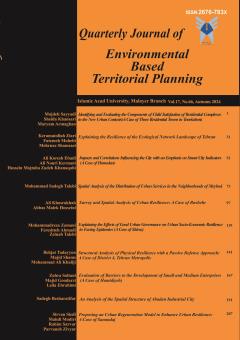Identifying and Evaluating the Components of Child Satisfaction of Residential Complexes in the New Urban Contexts (A Case of Three Residential Towns in Tonekabon)
Subject Areas :mozhde sayadi 1 * , sheida khansari 2 , maryam armaghan 3
1 - Ph.D. Student, Department of Architecture, Qazvin Branch, Islamic Azad University, Qazvin, Iran
2 - Assistant Professor, Department of Architecture, Qazvin Branch, Islamic Azad University, Qazvin, Iran
3 - Assistant Professor, Department of Architecture, Qazvin Branch, Islamic Azad University, Qazvin, Iran
Keywords: life satisfaction, components of housing, formal operation, mental and concrete dimensions, residential satisfaction,
Abstract :
The purpose of the present study was to evaluate the factors influencing children’s satisfaction with the residential complexes where they live. The research is developmental-applied in nature and its method is a mixed approach (qualitative and quantitative) as well as descriptive-correlational. The statistical population includes children aged 11-15 living in newly constructed residential complexes in three neighborhoods: Kaj, Aramesh, and Karimabad in the city of Tonekabon. A sample of 100 girls and 100 boys was selected. The data collection tool in this study was a validated questionnaire. To analyze the findings, the SPSS.19 software and Pearson correlation, regression, and Friedman tests were used. The findings indicated that the residential environment contributes to children’s satisfaction through objective and subjective dimensions, with impact levels of 7.78 and 5.75, respectively. These dimensions are divided into physical-neighborhood unit, physical-residential unit, environmental-neighborhood unit, and personal factors, each comprising different components and indicators. The impact levels of these factors on children’s satisfaction are 9.06, 6.50, 6.45, and 4.00, respectively. Finally, several practical strategies were presented to enhance residential satisfaction.
1. امین پور، ا؛ مدنی، ر؛ حیاتی، ح؛ دلداده، م. ع، (1394)، بازشناسی مفاهیم مسکن و سکونت بر اساس آموزههای اسلامی. نشریه مدیریت شهری، 40(4): 59-47.
2. آروین، م؛ فرجی، ا؛ آژند؛ م، (1398)، تأثیر رضایتمندی سکونتی بر ماندگاری جمعیت در طرحهای مسکن مهر شهر بهبهان. فصلنامه علمی و پژوهشی پژوهش و برنامهریزی شهری, 11(41)، 83-98.
3. آصفي، م؛ ایمانی، ا، (1395)، باز تعریف الگوهای طراحی مسکن مطلوب ایرانی- اسلامی معاصر با ارزیابی کیفی خانههای سنتی. فصلنامه پژوهشهای معماری اسلامی، 2(4): 75-56.
4. بهزادفر، م؛ قاضی زاده، س. ن، (1390)، حس رضایت از فضای باز مسکونی (نمونه موردی: مجتمعهای مسکونی شهر تهران). نشریه هنرهای زیبا-معماری و شهرسازی، 45(3): 24-15.

